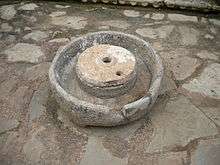Atta flour
Atta is an Indian wheat flour used to make most South Asian flatbreads, such as chapati, roti, naan and puri. Most atta is milled from the semi-hard wheat varieties, also known as durum wheat, that comprise 90% of the Indian wheat crop, and is more precisely called durum atta.[1]
Hard wheats have a high content of gluten (a protein composite that gives elasticity), so doughs made out of atta flour are strong and can be rolled out very thin.[2] Indian wheat is mostly Durum wheat, which are high in protein but less in "bread forming gluten" so the bread when baked with this flour does not rise as well and tends to be dense.
Etymology
Atta is the Hindi or Urdu word for dough; it is used by metonymy to mean "flour used for baking". Atta refers to the pulverized whole wheat with brownish white color. In India and Pakistan a common term used for atta is "chakki atta" which is mostly used in rural areas. Chakki atta is ground wheat without any additions or subtractions, and is thus in more natural form. The word Chakki derives its meaning from traditional Indian way of grinding wheat in between two stone plates; modern day flour mills use stone crushers in the flour milling process.
Wheat powder / flour, atta, sooji, maida
In India and Pakistan wheat products like 'wheat powder' or 'wheat flour', 'atta flour', 'maida flour' and 'sooji' (semolina, also known as 'rava') are available in the market. There is technical difference between maida flour and sooji flour in terms of bran content; Maida has negligible bran content. Maida flour is used mainly for making bhaturas and naan, types of Indian breads similar to roti or chapati, while sooji is used mainly in the preparation of a delight "kesari".
Whole wheat grains
Whole wheat grains contain all three parts of the kernel (kernel means a grain or seed, as of a cereal grass, enclosed in a husk). There are, mainly, three parts for a wheat grain.
Parts of a wheat grain

- Germ (2%) – Embryo of the wheat kernel.
- Endosperm (85%) – Nutritive tissue surrounding the embryo.
- Bran – Multi-layered outer skin of the kernel.
India/Pakistan: products of pulverized wheat grains
- Wheat powder/flour – 'Whole Grain' (Mixture of germ, endosperm and bran)
- Atta flour – mixture of endosperm and bran
- Maida flour – endosperm
- Sooji/rava – coarse endosperm
Preparation

The Atta flour found in commerce varies in fiber content from near 0% to 12%. Wholemeal (US whole wheat) atta is obtained from grinding complete wheat grains. It is creamy brown in color and quite coarse compared to other types of flour.
Traditionally, atta is made by stone grinding, a process that imparts a characteristic aroma and taste to the bread. The high bran content of wholemeal atta makes it a fiber-rich food. This may help to regulate blood sugar as well have other health benefits. The temperatures attained in a chakki (mill or grinder, traditionally from stone),[3][4] produced by friction, are of the order of 110–125 deg C. At such high temperatures, the carotenes present in the bran tend to exude the characteristic roasty smell, and contribute to the sweetness of the atta.
The various quality control parameters for the atta industry are ash content, moisture content, acid insoluble ash, water absorption, alcoholic acidity, granulation profile, damaged starch and gluten content.


